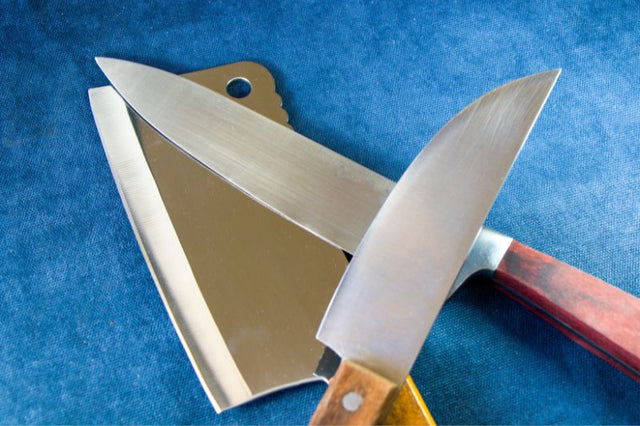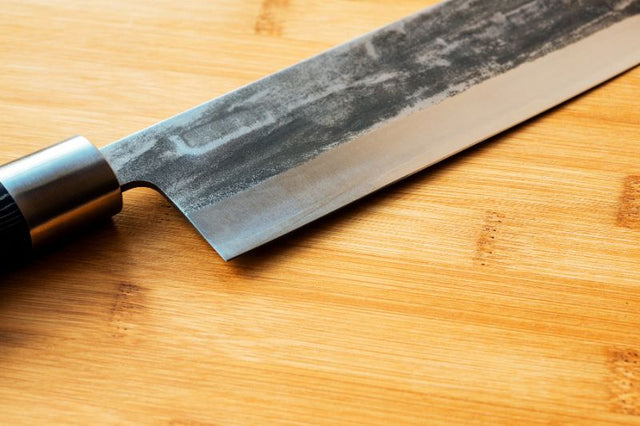We carefully avoid having our knives rusty and chipped. Japanese knives are more efficient but are more delicate than other knives. Although Japanese knives are good tools when slicing meats and vegetables. These knives are famous worldwide and used by highly skilled chefs.
Why do Japanese knives chip?
Japanese knives can chip for several reasons.
1. Dull or damaged edge
Over time, a knife's edge can become dull or damaged from regular use. These can increase the risk of chipping significantly when cutting harder materials.
2. Incorrect use
Using a Japanese knife improperly, such as by applying too much force or using a chopping motion instead of a rocking motion, can increase the risk of chipping.
3. Hard cutting surface
Using a hard cutting surface, such as granite or glass, can put excessive stress on the knife's edge and increase the risk of chipping.
4. Improper storage
Storing Japanese knives in a manner that subjects them to excessive force, such as by tossing them in a drawer, can increase the risk of chipping.
5. Poor quality materials
Some lower-quality Japanese knives are made from brittle or soft materials that are more prone to chipping. (All our knives are not this type, we assure you)
By taking proper care of your Japanese knives and using them correctly, you can reduce the risk of chipping and extend the life of your knives.
Edge chipping on Japanese knives is a common issue, but there are several ways to minimize it:
1. Keep the edge sharp
Regular honing and sharpening will help maintain the edge and reduce the risk of chipping. Japanese knives are sharpened to a very fine edge and need to be maintained to retain their sharpness.
2. Use a cutting board
Soft cutting boards, such as bamboo or plastic, will reduce the amount of stress placed on the knife's edge and minimize chipping. Avoid using hard surfaces like granite or glass, which can dull the edge and increase the risk of chipping.
3. Use the proper technique
When using a Japanese knife, make sure to use a rocking motion instead of a chopping motion to prevent chipping. This motion will help distribute the force of the cut evenly across the edge, reducing the risk of chipping.
4. Handle with care
Avoid twisting or bending the blade while cutting or using excessive force. These actions can cause stress on the edge and increase the risk of chipping.
5. Store knives properly
When storing Japanese knives, it's essential to keep them in a safe place where they won't bump into other objects or be subjected to excessive force. This will help protect the edge and reduce the risk of chipping.
Following these tips can minimize edge chipping and keep your Japanese knives in great condition.
A chipped knife can be dangerous, as the chipped edge can easily get caught on food or other items and cause the knife to slip. This slip can result in cuts or other injuries.
Additionally, a chipped edge can cause the knife to be less effective when cutting and may result in uneven slices or crushed food. Uneven slicing can negatively impact the overall quality of your cooking.
For these reasons, it's generally best to avoid using a chipped knife and to have the edge repaired as soon as possible. If you need to use the knife, be extra careful and avoid putting excessive pressure on the chipped edge.

How to repair a chipped knife?
Fixing a chipped Japanese knife requires honing and sharpening the edge to remove the chip. Here are the steps you can follow:
1. Sharpen the knife
Use a sharpening stone or a honing rod to sharpen the edge of the knife. Start with a coarser grit stone and progress to a finer grit stone to remove the chip and restore the edge.
2. Check the angle
Ensure that you maintain the correct angle while sharpening the knife to avoid damaging the edge further. Japanese knives are typically sharpened to a very fine angle, so it's important to be careful.
3. Hone the knife
After sharpening, use a honing rod to realign the edge and remove any burrs. This way will help keep the edge sharp and reduce the risk of chipping in the future.
4. Test the knife
After honing, test the knife to ensure the chip has been removed and the edge is sharp. You may need to repeat the sharpening process if the chip is still present.
Note: If the chip is severe, it may not be possible to repair the knife by honing and sharpening alone. If that is the case, it may be necessary to have the blade professionally repaired or replaced.
If you are unsure about your knife sharpening and honing skills, it's best to take it to a professional sharpener. They can quickly and effectively restore the edge and lessen the risk of further damage to the knife.
Get Free Bonus Books

Sign up for free to the Japanese Knife Club to get advice and exclusive articles about how to choose Japanese Knives, and tips and tricks for using Japanese knives.
About the author
Kei Nishida
Author, CEO Dream of Japan
Certification: PMP, BS in Computer Science
Education: Western Washington University
Kei Nishida is a passionate advocate of Japanese craftsmanship, a writer, and the founder and CEO of Japanese Knife Co., Japanese Green Tea Co., and Japanese Coffee Co., all part of Dream of Japan.
His journey began with a mission to introduce the world to the exquisite flavors of Japanese green tea. Through Japanese Green Tea Co., he pioneered the import of premium tea grown in nutrient-rich sugarcane soil, earning multiple Global Tea Champion awards. He then expanded into the world of coffee, launching Japanese Coffee Co., the first company to bring Sumiyaki charcoal-roasted coffee to a global audience.
With a deep appreciation for Japanese artistry and tradition, Kei turned his attention to one of Japan’s most revered crafts: bladesmithing. Through Japanese Knife Co., he made handcrafted katana-style knives, created by a renowned katana maker, available outside Japan for the first time. These exceptional knives embody centuries of samurai sword-making expertise, blending tradition with modern functionality for chefs and collectors alike.
Kei’s journey continues as he uncovers and shares Japan’s hidden treasures—one sip, one blade, and one legacy at a time.



















